
Key Takeaways
- Parsley contains high levels of chlorophyll, making it an excellent natural detoxifying agent that can help remove harmful toxins from your body.
- Just half a cup of fresh parsley provides more than 100% of your daily vitamin K needs and significant amounts of vitamins A and C.
- Both curly and flat-leaf parsley varieties offer similar nutritional benefits, though flat-leaf (Italian) parsley contains slightly higher concentrations of essential oils.
- Regular consumption of parsley may support kidney function, reduce inflammation, and protect against chronic diseases through its powerful antioxidant properties.
- Beyond garnishing, parsley can be incorporated into smoothies, pestos, and teas to maximize its health-promoting benefits.
That bunch of parsley sitting in your refrigerator or wilting as a garnish on your plate is actually one of nature’s most overlooked medicinal powerhouses. This unassuming herb does far more than add color to your plate—it’s packed with chlorophyll, vitamins, and healing compounds that can transform your health from the inside out.
Why Parsley Is More Than Just a Garnish
For too long, parsley has been relegated to the edge of the plate, a mere afterthought in culinary creations. This humble herb deserves center stage in your kitchen and wellness routine. What appears to be a simple garnish is actually a concentrated source of nutrients that ancient healers have relied on for centuries. From the Mediterranean to Middle Eastern cultures, parsley has been revered not just for its distinctive flavor but for its remarkable medicinal properties.
Nutritional Powerhouse Hidden in Plain Sight
Beneath parsley’s vibrant green exterior lies an impressive array of nutrients that can support overall health. A half cup (30 grams) of fresh parsley contains more vitamin K than most people need in an entire day—over 500% of the recommended daily intake. This seemingly small addition to your meals also provides significant amounts of vitamin A, vitamin C, and folate. What’s particularly remarkable is that parsley achieves this nutritional density while contributing very few calories to your diet—making it one of the most nutrient-dense foods on the planet.
The herb’s rich nutritional profile extends beyond vitamins to include essential minerals like iron, calcium, and potassium. These minerals work synergistically with parsley’s vitamins to support everything from bone health to immune function. Even more impressive is that you don’t need to consume large amounts to benefit—just a few tablespoons daily can significantly impact your nutritional intake.
Chlorophyll Content That Rivals Green Superfoods

The vibrant green color of parsley comes from its abundant chlorophyll content—the same compound that allows plants to convert sunlight into energy. This chlorophyll is what sets parsley apart from many other herbs and places it firmly in the category of detoxifying superfoods. In fact, parsley contains one of the highest concentrations of chlorophyll found in any food, rivaling other green superstars like wheatgrass and spirulina.
Chlorophyll’s molecular structure is remarkably similar to hemoglobin, the oxygen-carrying component of human blood. This structural similarity allows chlorophyll to help with the formation of red blood cells and improve oxygen transport throughout your body. The resulting increase in cellular oxygenation can lead to improved energy levels and enhanced overall vitality. Additionally, studies have shown that chlorophyll compounds can bind to potential carcinogens in the digestive tract, limiting their absorption and helping to remove them from the body. For more information on chlorophyll-rich herbs, you might want to explore the benefits of nasturtium.
Both Curly and Flat-Leaf Varieties Offer Health Benefits
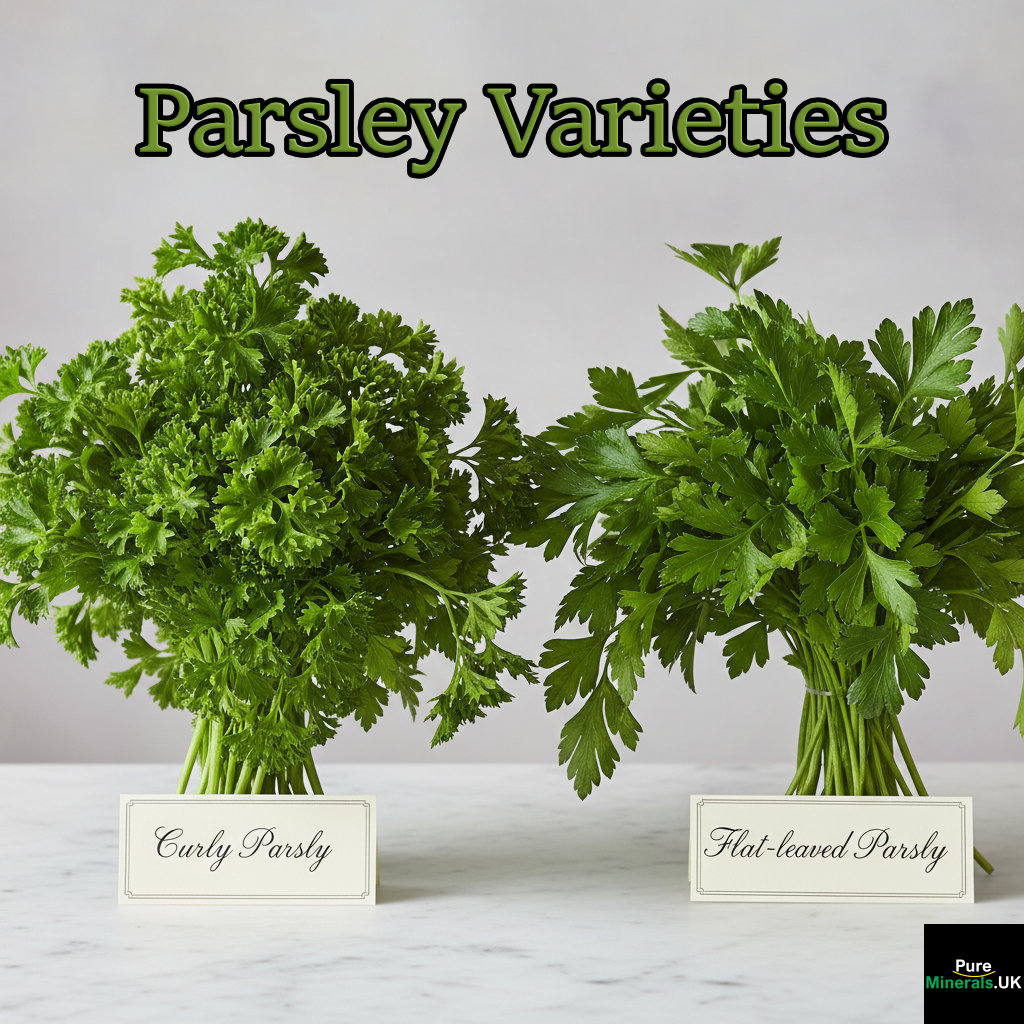
Whether you prefer the decorative curly-leaf parsley or the more robust-flavored flat-leaf (Italian) variety, you’re getting exceptional nutritional value. While both types share similar nutritional profiles, some subtle differences exist. Flat-leaf parsley tends to have a stronger flavor and slightly higher concentrations of essential oils, which contribute to its aromatic qualities and some of its therapeutic effects.
Curly parsley, with its tighter leaf structure, may be slightly better at trapping air pollutants when grown, making it an excellent detoxifier. However, both varieties contain the full spectrum of parsley’s beneficial compounds, including flavonoids, carotenoids, and volatile oils that contribute to the herb’s medicinal properties. The choice between them comes down more to culinary preference than nutritional difference—so feel free to use whichever variety appeals to your palate.
Parsley’s Impressive Nutritional Profile
The nutritional density of parsley is truly remarkable when you consider its small serving size. This herb packs a powerful punch that far exceeds many foods several times its volume. Understanding exactly what’s in that sprig of parsley helps explain why it’s been treasured for both culinary and medicinal purposes across cultures and throughout history.
Essential Vitamins and Minerals in Each Serving
Parsley stands out as a nutritional superstar, particularly in its vitamin content. A single half-cup serving of fresh parsley contains 547% of the daily value for vitamin K, essential for proper blood clotting and bone health. The same serving provides 62% of your daily vitamin C needs, supporting immune function and collagen formation. Vitamin A, crucial for vision and immune health, is present at levels reaching 83% of daily requirements in that same small serving.
The mineral content of parsley is equally impressive. It contains meaningful amounts of iron (21% of daily needs), calcium (9%), and potassium (7%) in each half-cup serving. These minerals support everything from oxygen transport and nerve function to maintaining healthy blood pressure. Parsley also provides smaller amounts of magnesium, manganese, and copper—trace minerals that serve as cofactors in hundreds of enzymatic reactions throughout the body.
Antioxidant Content That Fights Free Radicals
Parsley is exceptionally rich in antioxidants that combat oxidative stress in your body. The flavonoids in parsley—including luteolin, apigenin, and chrysoeriol—are powerful compounds that neutralize free radicals before they can damage cells and DNA. Research has shown that parsley extract has up to 17 times more antioxidant activity than many other herbs and vegetables when measured gram for gram.
What makes parsley unique is that its antioxidant profile is complemented by its high chlorophyll content, creating a synergistic effect that enhances its protective benefits. This combination makes parsley particularly effective at reducing inflammation at the cellular level. Regular consumption of parsley may help protect against chronic diseases and slow aging processes that are accelerated by oxidative damage. For similar benefits, you might also explore the properties of oregano, which is another herb known for its health benefits.
Calorie Count and Macronutrient Breakdown
For those watching their caloric intake, parsley offers tremendous nutritional value with minimal calories. A half-cup serving of fresh parsley contains just 11 calories, with 1.8 grams of protein, 2 grams of carbohydrates, and less than 0.5 grams of fat. This makes it an excellent addition to any diet, providing substantial nutrients without contributing significantly to daily calorie consumption.
How Parsley Compares to Other Common Herbs
Nutrient Density Comparison (per 100g)
Parsley: 133 mg Vitamin C, 1640 μg Vitamin K, 421 μg Vitamin A
Cilantro: 27 mg Vitamin C, 310 μg Vitamin K, 337 μg Vitamin A
Basil: 18 mg Vitamin C, 415 μg Vitamin K, 264 μg Vitamin A
Mint: 31 mg Vitamin C, 266 μg Vitamin K, 212 μg Vitamin A
The Detoxifying Properties of Parsley
In our increasingly toxic world, finding natural ways to support our body’s detoxification systems has never been more important. Parsley stands out as one of nature’s most effective detoxifiers, working at multiple levels to cleanse and rejuvenate. Its complex array of compounds works synergistically to support elimination pathways and protect organs responsible for filtering toxins from our bloodstream.
The remarkable detoxification properties of parsley can be attributed to both its nutrient content and its unique phytochemical profile. These natural compounds enhance the body’s own detoxification mechanisms rather than forcing artificial cleansing, making parsley a gentle yet effective addition to any detox protocol.
How Chlorophyll Acts as a Natural Detoxifier
Chlorophyll, the pigment that gives parsley its vibrant green color, is a powerful detoxifying agent. It binds with toxins in the digestive tract, preventing their absorption and facilitating their elimination from the body. This binding action is particularly effective with environmental toxins like heavy metals and certain carcinogenic compounds found in processed foods and polluted air.
Beyond binding to toxins, chlorophyll stimulates the production of glutathione, often called the body’s master antioxidant. Glutathione is essential for Phase II liver detoxification—the process that transforms toxins into water-soluble compounds that can be excreted through urine. By boosting glutathione levels, parsley’s chlorophyll content supports optimal liver function and enhances the body’s natural detoxification capacity.
The molecular structure of chlorophyll closely resembles that of hemoglobin, allowing it to support blood purification and enhance oxygen delivery to cells. This improved oxygenation creates an environment where healing can occur more efficiently and toxins can be processed more effectively by the body’s detoxification systems.
Kidney and Liver Support Benefits
Parsley has been used traditionally as a natural diuretic, helping to flush toxins through the urinary tract and support kidney function. Its mild diuretic effect increases urine output without depleting electrolytes, making it gentler than pharmaceutical diuretics. This property makes parsley particularly valuable for those with mild water retention or those looking to support kidney health naturally.
Parsley’s Role in Heavy Metal Removal
The chelating compounds in parsley help bind to heavy metals like mercury, lead, and cadmium, facilitating their removal from tissues and bloodstream. This chelating action is complemented by parsley’s high levels of antioxidants, which protect cells from the oxidative damage often caused during the detoxification process. Regular consumption of parsley can be part of a comprehensive approach to reducing toxic burden, especially for those exposed to environmental pollutants.
Science Behind Parsley’s Cleansing Effects
Research has demonstrated that compounds in parsley, particularly apigenin and myristicin, activate enzymes in the liver that help process and eliminate toxins. These compounds specifically enhance Phase I and Phase II detoxification pathways, the biochemical processes responsible for neutralizing harmful substances. By supporting these pathways, parsley helps the body process everything from environmental pollutants to metabolic waste products more efficiently. For more information on herbs with detoxifying properties, you might explore the benefits of oregano as well.
Parsley’s volatile oils, including myristicin, eugenol, and limonene, have been shown to inhibit tumor formation in animal studies, particularly in the lungs. These same compounds appear to neutralize certain carcinogens, such as those found in cigarette smoke and charred meat. This protective effect represents another dimension of parsley’s detoxifying capabilities—preventing damage before it occurs.
Health Benefits Beyond Detoxification
While parsley’s detoxifying properties are impressive, this versatile herb offers a much wider spectrum of health benefits. From reducing inflammation to protecting your vision, parsley’s diverse array of nutrients and bioactive compounds contribute to whole-body wellness in ways that extend far beyond basic cleansing.
Anti-Inflammatory Properties
Parsley contains powerful flavonoids that have been shown to inhibit the release of pro-inflammatory markers in the body. These compounds, particularly luteolin and apigenin, help reduce inflammation by blocking the production of cytokines and other inflammatory mediators. This anti-inflammatory action may help alleviate symptoms of inflammatory conditions like arthritis and autoimmune disorders when parsley is consumed regularly.
The volatile oils in parsley, including myristicin and limonene, further contribute to its anti-inflammatory effects by inhibiting certain pro-inflammatory enzymes. Research suggests that these compounds may be particularly effective at reducing inflammation in the digestive tract, making parsley a valuable herb for those with inflammatory bowel conditions or digestive sensitivities. For those interested in exploring other anti-inflammatory herbs, oregano is another option worth considering.
Blood Sugar Regulation Effects
Preliminary research indicates that compounds in parsley may help regulate blood sugar levels by improving insulin sensitivity and reducing glucose absorption in the intestines. While more studies are needed, incorporating parsley into meals may help moderate blood sugar spikes, particularly when consumed as part of a balanced meal containing protein, fiber, and healthy fats.
Heart Health Support
The folate and antioxidants in parsley work together to reduce homocysteine levels in the blood, a risk factor for heart disease. Additionally, parsley’s natural diuretic effect helps reduce blood pressure by eliminating excess sodium and water, while its high potassium content helps maintain proper electrolyte balance and cardiovascular function. These combined effects make parsley a heart-friendly addition to any diet.
Eye Protection from Carotenoids
Parsley is rich in lutein and zeaxanthin, carotenoids that accumulate in the retina and protect eye cells from damage caused by blue light and oxidative stress. These compounds act as natural sunscreen for your eyes, filtering harmful high-energy light waves that can contribute to age-related macular degeneration and cataracts. Research suggests that diets rich in these carotenoids can significantly reduce the risk of developing these common age-related eye conditions.
The vitamin A in parsley further supports eye health by maintaining the health of the cornea and conjunctival membranes. Adequate vitamin A is essential for good night vision and helps prevent dry eyes. Just a quarter cup of chopped parsley provides about 40% of your daily vitamin A needs, making it an excellent food for maintaining optimal vision.
Bone Health Enhancement
The exceptional vitamin K content in parsley makes it one of the best herbs for supporting bone health. Vitamin K is essential for proper calcium utilization in bone tissue, and studies show that adequate vitamin K intake is associated with reduced risk of fractures and higher bone mineral density. Just one tablespoon of parsley provides more than your entire daily requirement of this crucial vitamin.
How Much Parsley Should You Consume Daily?
Finding the right amount of parsley to incorporate into your diet balances getting maximum benefits without overdoing it. While parsley is generally safe for most people, there are optimal amounts to target for therapeutic effects and some considerations to keep in mind for special populations.
Like many herbs with medicinal properties, parsley follows a dose-response curve where benefits increase up to a certain threshold before potential downsides may emerge. Understanding appropriate consumption levels helps you harness the full potential of this chlorophyll-rich herb.
Recommended Intake for Therapeutic Benefits
For general health maintenance and gentle detoxification support, consuming 1-2 tablespoons of fresh chopped parsley daily is a good starting point. This amount provides significant chlorophyll and vitamin K while being easily incorporated into meals. For more targeted therapeutic benefits, herbalists often recommend gradually increasing to 1/4 to 1/2 cup of fresh parsley daily, which can be divided between meals throughout the day.
Parsley tea, made by steeping 2-3 teaspoons of fresh leaves in hot water, can be consumed 1-2 times daily as part of a detoxification regimen. For concentrated benefits, fresh parsley juice—typically 1-2 ounces diluted with other vegetable juices—provides maximum chlorophyll content and can be particularly effective for cleansing protocols. Always start with smaller amounts and gradually increase to assess your body’s response.
Potential Side Effects of Excessive Consumption
Despite its many benefits, consuming excessive amounts of parsley can have some unwanted effects. The high vitamin K content may interfere with blood-thinning medications like warfarin, potentially reducing their effectiveness. Very large amounts of parsley, particularly in concentrated forms like juice or essential oil, may cause uterine contractions due to compounds like myristicin and apiole.
Some individuals may experience photosensitivity with extremely high parsley consumption, making skin more vulnerable to sun damage. Those with kidney disorders should be cautious with parsley’s diuretic properties, as they could potentially stress already compromised kidney function. If you experience any unusual symptoms after increasing parsley intake, reduce the amount and consult with a healthcare provider.
Special Considerations for Pregnant Women
Pregnant women should limit parsley consumption to normal culinary amounts found in everyday cooking. The concentrated volatile oils in large therapeutic doses of parsley (particularly parsley seed oil) may stimulate uterine contractions, which could potentially be problematic during pregnancy. Always consult with a healthcare provider before using any herbs medicinally during pregnancy or breastfeeding.
Grow Your Own Parsley: Tips for Success

Growing your own parsley ensures the freshest supply with maximum nutritional value and chlorophyll content. This biennial herb is relatively easy to cultivate and provides leaves for harvesting throughout its growing season. Plus, home-grown parsley allows you to avoid pesticides and control growing conditions for the healthiest possible herbs.
Indoor vs. Outdoor Growing Methods
Parsley can thrive both indoors and outdoors, making it versatile for any living situation. Indoor growing provides year-round access regardless of climate but requires attention to light conditions. Place parsley pots in a south-facing window that receives at least 6 hours of sunlight daily, or use grow lights positioned 6-8 inches above the plants for 12-14 hours daily to ensure proper development of chlorophyll and essential oils.
Outdoor cultivation typically yields more abundant growth and higher chlorophyll content due to full sun exposure. Plant parsley in spring after the last frost, choosing a location with morning sun and afternoon shade in warmer climates. Parsley grows well in garden beds, raised planters, or containers at least 8 inches deep to accommodate its taproot.
For continuous harvest, consider succession planting every 3-4 weeks during growing season, or maintain both indoor and outdoor plants to ensure year-round supply. Parsley is slow to germinate (often taking 2-3 weeks), so patience is required when starting from seed. Pre-soaking seeds for 24 hours can help speed germination. Additionally, incorporating companion plants like mint can enhance growth and flavor.
- Indoor benefits: Year-round growing, protection from pests, convenient harvest
- Outdoor benefits: Larger yields, higher essential oil content, less maintenance
- Container growth: Perfect for balconies and small spaces, allows moving plants as needed
- In-ground planting: Develops stronger root systems and more robust plants
Soil and Watering Requirements
Parsley thrives in rich, well-draining soil with plenty of organic matter. A soil pH between 6.0 and 7.0 is ideal for optimal nutrient absorption and chlorophyll development. Before planting, amend garden soil with compost or well-rotted manure to improve fertility and structure. For containers, use a high-quality organic potting mix combined with about 20% compost to provide sustained nutrition.
Consistent moisture is essential for parsley, but waterlogged conditions can lead to root rot. Water deeply when the top inch of soil feels dry, typically every 2-3 days for container plants and less frequently for garden beds. Apply a thin layer of mulch around plants (but not touching stems) to retain soil moisture and regulate temperature. During hot weather, more frequent watering may be necessary to prevent wilting and maintain the plant’s chlorophyll production.
Harvesting Techniques to Promote Regrowth
Proper harvesting techniques not only provide you with fresh parsley but also stimulate the plant to produce more leaves. Begin harvesting when plants have developed several stalks with multiple leaf sets, typically about 70-90 days after planting. Always harvest outer stems first, cutting close to the base of the plant with sharp scissors or garden shears to encourage new growth from the center.
For maximum chlorophyll content, harvest parsley in the morning after dew has dried but before the heat of the day. This timing captures the highest concentration of essential oils and nutrients. Never remove more than one-third of the plant at once to ensure it has enough foliage to continue photosynthesis and regeneration. With proper care and harvesting, a single parsley plant can provide regular harvests for up to two years before flowering and completing its life cycle.
Transform Your Health with this Overlooked Herb
Parsley’s remarkable chlorophyll content, combined with its impressive nutrient profile, makes it one of nature’s most powerful healing herbs. By incorporating this vibrant green herb into your daily routine—whether sprinkled fresh on meals, blended into smoothies, or steeped as tea—you’re supporting your body’s natural detoxification systems and providing concentrated nutrition that few other foods can match. The journey to better health often begins with small, consistent changes, and adding parsley to your regular diet represents one of the simplest yet most effective steps you can take.
Remember that the true power of parsley lies not just in occasional use but in making it a regular part of your culinary and wellness practices. As with any natural approach to health, consistency yields the most profound results. Let this chlorophyll-rich herb become your ally in navigating today’s toxic world, providing cellular protection and gentle, effective detoxification support every day. Your body will thank you with increased energy, improved digestion, and the vibrant health that comes from nourishing yourself with one of nature’s green treasures.
Top 5 Parsley Recipes
Parsley is an exceptionally versatile herb that enhances flavour, freshness, and presentation in a wide range of cuisines. The following 5 recipes are among the most popular and enduring dishes that showcase parsley as a central ingredient rather than a mere garnish:
1. Tabbouleh (Lebanese Parsley Salad)
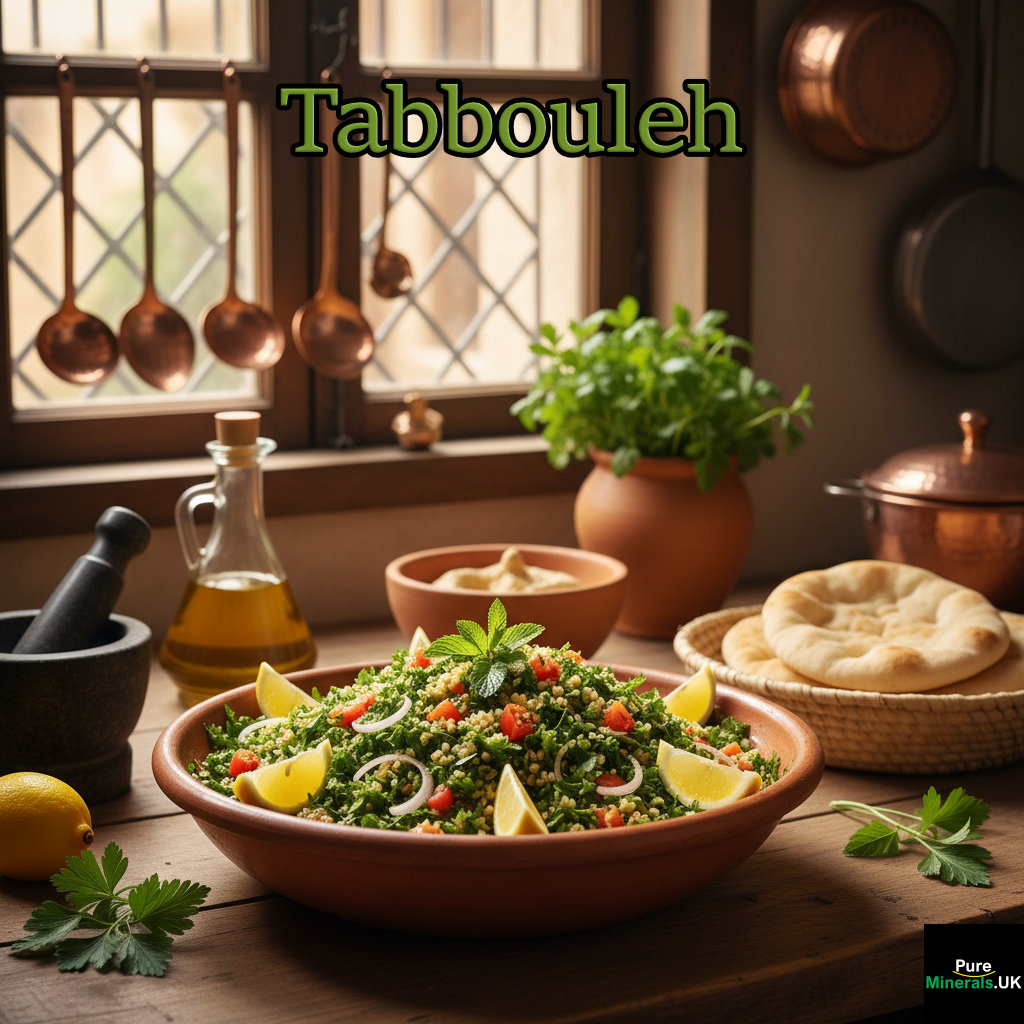
Origin: Middle Eastern
Key Feature: Parsley as the main ingredient
Ingredients:
- 2 large bunches fresh flat-leaf parsley, finely chopped
- 1/2 cup fine bulgur wheat
- 3 tomatoes, finely diced
- 4 spring onions or 1 small red onion, finely chopped
- 1/4 cup fresh mint leaves, chopped
- Juice of 2 lemons
- 1/4 cup extra-virgin olive oil
- Salt and pepper to taste
Method:
- Soak bulgur in boiling water for 15 minutes, then drain and squeeze dry.
- Combine parsley, mint, tomatoes, and onion in a bowl.
- Stir in the bulgur, then add lemon juice, olive oil, salt, and pepper.
- Mix well and chill before serving.
Why it stands out: A vibrant, zesty salad where parsley’s freshness is the star.
2. Chimichurri Sauce (Argentinian Herb Marinade)
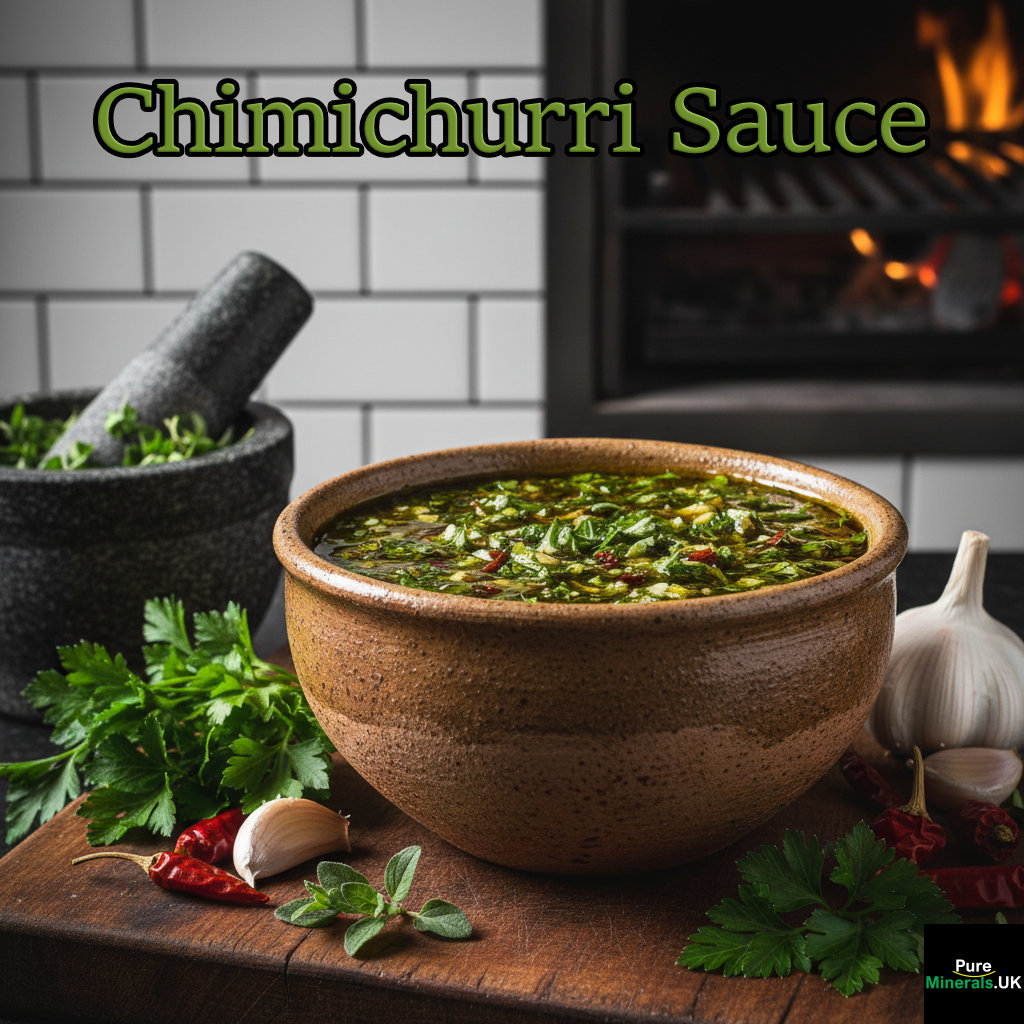
Origin: Argentina/Uruguay
Key Feature: A bold parsley-based condiment
Ingredients:
- 1 cup fresh flat-leaf parsley, finely chopped
- 3–4 garlic cloves, minced
- 2 tbsp fresh oregano or 1 tsp dried
- 1/2 cup olive oil
- 2 tbsp red wine vinegar
- 1 tsp crushed red pepper flakes
- Salt and black pepper to taste
Method:
- Combine parsley, garlic, and oregano in a bowl.
- Stir in olive oil, vinegar, red pepper flakes, salt, and pepper.
- Let it rest for 30 minutes before serving with grilled meat, fish, or vegetables.
Why it stands out: A sharp, garlicky sauce where parsley balances acidity and heat.
3. Gremolata (Italian Parsley–Lemon Garnish)
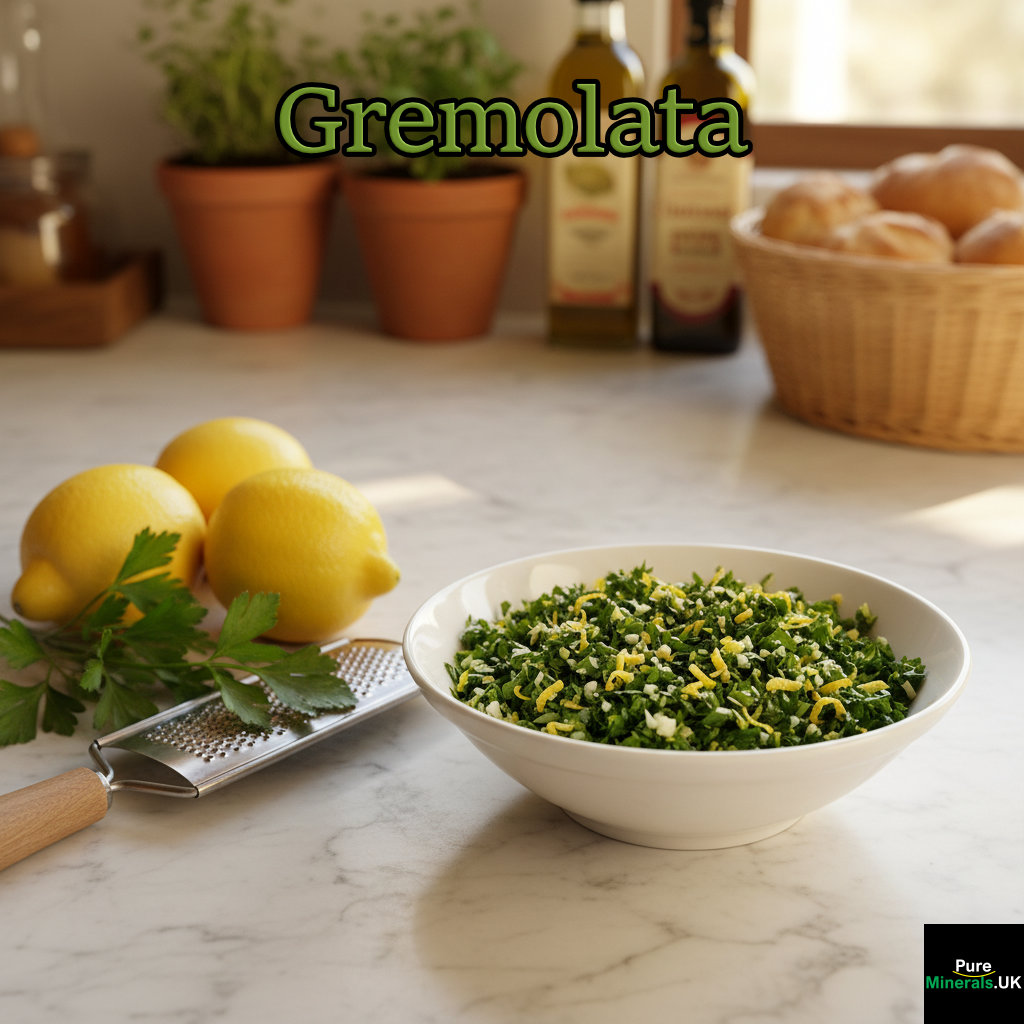
Origin: Lombardy, Italy
Key Feature: Fresh finishing garnish for Osso Buco or fish
Ingredients:
- 1/2 cup flat-leaf parsley, finely chopped
- Zest of 1 large lemon
- 1 garlic clove, minced
Method:
- Combine parsley, lemon zest, and garlic in a bowl.
- Mix thoroughly just before serving.
Why it stands out: A simple yet powerful flavour enhancer that brightens rich stews, meats, or pasta.
4. Parsley Pesto
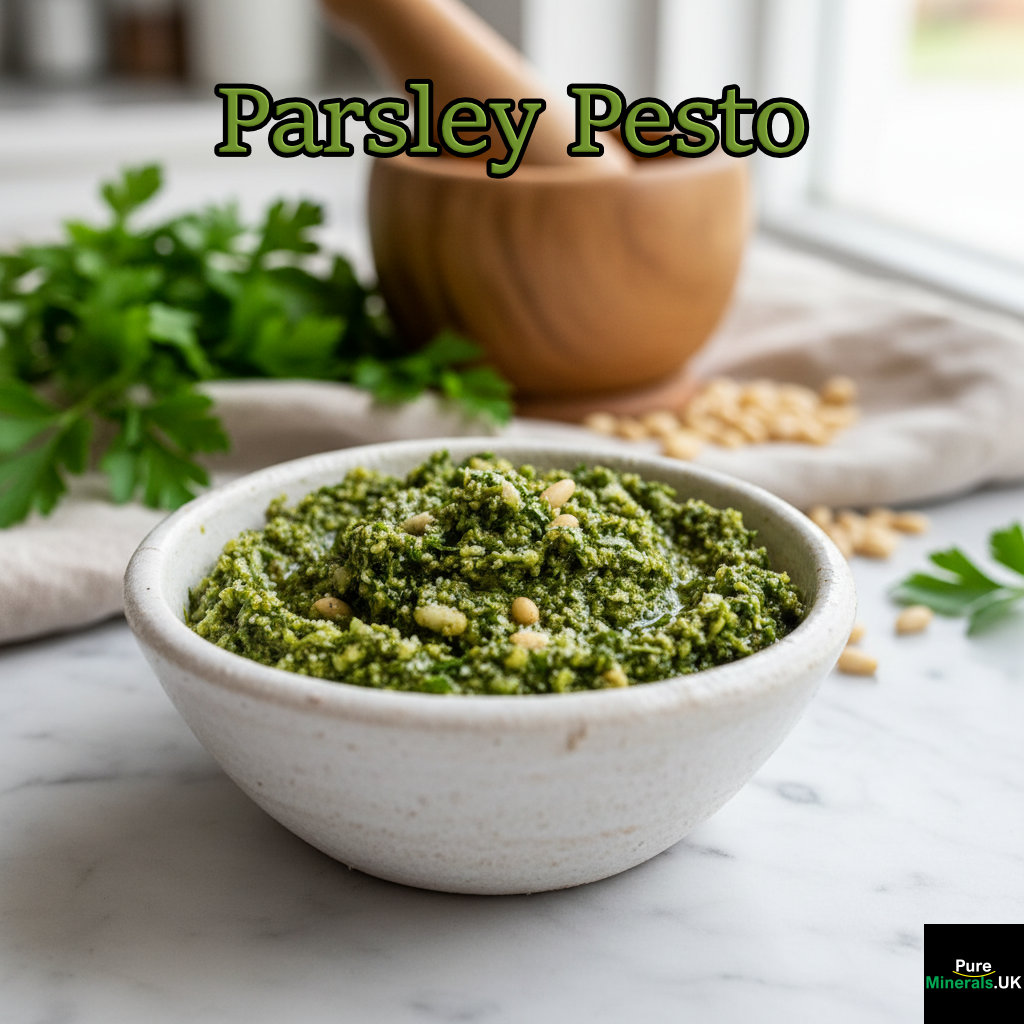
Origin: Modern Italian variation
Key Feature: A vibrant green sauce without basil
Ingredients:
- 2 cups flat-leaf parsley leaves
- 1/2 cup grated Parmesan cheese
- 1/2 cup toasted walnuts or pine nuts
- 2 garlic cloves
- 1/2 cup olive oil
- Salt and pepper to taste
Method:
- Blend parsley, nuts, cheese, and garlic until coarse.
- Slowly drizzle in olive oil while blending until smooth.
- Season to taste.
Why it stands out: A bright, slightly peppery alternative to classic basil pesto—excellent for pasta or drizzled on roasted vegetables.
5. Garlic Butter with Parsley (Café de Paris–Style Compound Butter)

Origin: French bistro tradition
Key Feature: Classic steak and seafood accompaniment
Ingredients:
- 1/2 cup unsalted butter, softened
- 2 tbsp fresh parsley, finely chopped
- 1–2 garlic cloves, crushed
- 1 tsp lemon juice
- Salt and pepper to taste
Method:
- Mash all ingredients together until fully combined.
- Roll into a log and refrigerate until firm.
- Slice over grilled steak, fish, or vegetables before serving.
Why it stands out: Parsley adds balance and freshness to the rich butter and garlic.
Frequently Asked Questions
Many people have questions about incorporating parsley into their wellness routine. Here are answers to some of the most common inquiries about this remarkable herb and its chlorophyll-rich properties.
Can parsley help with bad breath?
Yes, parsley is highly effective at freshening breath due to its high chlorophyll content. Chlorophyll acts as a natural deodorizer by neutralizing sulfur compounds that cause bad breath. Chewing fresh parsley leaves after meals can help eliminate garlic and onion odors while also supporting digestive health. For best results, choose the flat-leaf variety which contains slightly higher concentrations of the essential oils that contribute to this breath-freshening effect.
Is parsley safe for people with kidney problems?
Parsley should be used cautiously by those with existing kidney conditions. While its natural diuretic properties can support healthy kidney function in normal individuals, this same quality might place additional stress on compromised kidneys. The increased urination stimulated by parsley’s compounds could potentially alter fluid balance and electrolyte levels in those with kidney disease.
Anyone with kidney stones should be particularly careful with parsley consumption. The herb contains oxalates, which can contribute to kidney stone formation in susceptible individuals. However, moderate culinary amounts (as a garnish or flavor enhancer) are generally considered safe for most people.
- Consult with a nephrologist before using parsley therapeutically
- Avoid concentrated forms like parsley juice if you have kidney issues
- Monitor fluid balance if incorporating more parsley into your diet
- Consider low-oxalate alternatives if you have calcium oxalate stones
If you’re under medical supervision for kidney disease, always discuss any dietary changes, including increased herb consumption, with your healthcare provider before making significant changes. You might also consider using lovage as an alternative herb.
Does cooking parsley destroy its nutritional benefits?
Cooking affects parsley’s nutritional profile, but doesn’t eliminate all benefits. Heat-sensitive nutrients like vitamin C and some antioxidants may decrease with prolonged cooking, while fat-soluble vitamins (A, K, E) and minerals remain relatively stable. The chlorophyll content diminishes somewhat but doesn’t disappear entirely when parsley is cooked. For maximum nutritional benefits, add parsley toward the end of cooking or use it raw.
Interestingly, some studies suggest that certain beneficial compounds in parsley become more bioavailable after light cooking. The gentle breakdown of cellular walls can release compounds that might otherwise pass through the digestive system unabsorbed. For balanced nutrition, incorporate both raw and lightly cooked parsley into your diet—raw in salads and garnishes for maximum enzyme and vitamin content, and lightly cooked in soups and sauces for enhanced absorption of certain phytonutrients.
Can parsley interact with medications?
Parsley can interact with several types of medications, with the most significant concern being blood thinners like warfarin (Coumadin). The high vitamin K content in parsley can reduce the effectiveness of these medications by promoting blood clotting. Individuals taking blood thinners should maintain consistent parsley intake rather than dramatically increasing or decreasing consumption, as vitamin K fluctuations can affect medication efficacy.
Additionally, parsley may enhance the effects of diuretic medications, potentially causing excessive fluid loss and electrolyte imbalances. Those taking lithium should also exercise caution, as parsley’s diuretic properties could potentially affect lithium levels in the blood. Always consult with your healthcare provider about potential herb-drug interactions, especially when using parsley in medicinal amounts rather than as a culinary herb.
What’s the difference between curly parsley and flat-leaf parsley?
The two common parsley varieties differ in both appearance and flavor profile. Curly parsley (Petroselinum crispum var. crispum) features tightly curled, bright green leaves with a mild, grassy flavor that makes it ideal as a decorative garnish. It tends to be slightly less intense in flavor but still offers comparable chlorophyll content and nutritional benefits to its flat-leaf counterpart.
Flat-leaf parsley (Petroselinum crispum var. neapolitanum), also called Italian parsley, has flat, broad leaves with pointed ends and a more robust, slightly peppery flavor profile. This variety contains marginally higher concentrations of essential oils, giving it a stronger taste that stands up well in cooked dishes. Many chefs prefer flat-leaf parsley for its more pronounced flavor and easier chopping, while curly parsley maintains its traditional role as a garnish.
Both varieties contain similar nutritional profiles, including high levels of vitamins K, C, and A, along with iron and other minerals. The chlorophyll content is comparable between the two, though some studies suggest flat-leaf varieties may have slightly higher antioxidant capacity. From a health perspective, either variety will provide excellent nutritional benefits, so the choice often comes down to culinary preference and intended use. For more information on the health benefits of parsley, you can visit Healthline.
For maximum health benefits, consider growing both varieties to enjoy their slightly different properties. Use flat-leaf in cooking for its robust flavor and curly parsley in fresh applications where its texture adds interest. Regardless of which type you choose, ensure it’s fresh and vibrant green for the highest chlorophyll content and nutritional value.
Remember that parsley seeds from both varieties can also be used medicinally, though they contain different compound ratios than the leaves and should be used with appropriate guidance from a qualified herbalist or healthcare provider. For those interested in exploring other herbs with medicinal properties, consider learning about marjoram, which also offers various health benefits.
For a chlorophyll-rich addition to your wellness routine, discover how incorporating more parsley into your diet can support natural detoxification and overall health. Visit our website for more information on using herbs for optimal wellness and detoxification.
